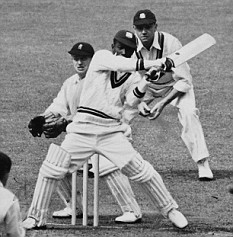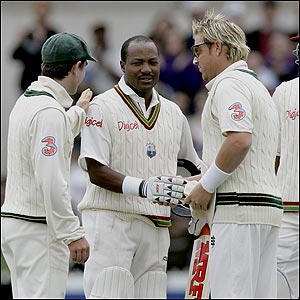Latest update April 3rd, 2025 5:06 PM
What cricket means to West Indians
Mar 25, 2020 Sports
By Sean Devers
Presently just the thought of West Indies cricket can take one into deep depression. Administrators, who only serve their own agendas, players, most of whom seem only motivated by money and fans who have lost all interest in watching Test cricket that involves a weak West Indies team are ‘normal’ today.But when Jamaican Robert Karl Nunes led the West Indies onto Lords on June 23rd 1928 to face England, it marked the birth of one of the most colourful and exciting teams to play test cricket and provided a major opportunity for West Indians to gain international acclaim.
In the early days the West Indies team, it comprised players from the British Federation along with British Guiana, located in South America. Today the team is made up of players from the English speaking Caribbean Islands and Guyana.
West Indies was the fourth team to play test cricket after Australia, England and South Africa.
In a region dominated by ‘whites’ in the days of slavery and indenture-ship cricket has played an important role in the social, economic, cultural and political development of Caribbean people.
The slave rebellion in the 1790s in Saint-Domingue resulted in Haiti becoming independent in 1804 to become the first black republic in the Americas.
Four years later Britain abolished the slave trade, while slavery itself was abolished in the British West Indies in 1833.
By 1838, the agriculture production in British Guiana (now Guyana) had fallen by 60 percent and plantations were being shut down since most of the freed slaves refused to work for plantation owners who had mistreated them.
With most of the freed slaves heading for towns or forming villages of their own, the plantation owners, in search of cheap labour, turned to immigrants from England, Germany, Ireland and the British West Indies; starting the indentured system.
However, due to the tough working conditions, these workers did not last long.During the days of slavery when the British were growing sugar cane in Guyana, they were also powerful in other parts of the world and had entered an Indian Province called Uttar Pradesh in 1765.
Under British rule in India, thousands of Indians were unemployed and living in poverty. Many who wanted to escape the poor living conditions opted to go to the ‘new world’ to work as indentured servants on the Sugar cane plantations in Guyana and later (1845) Trinidad and Jamaica.
By the 1860s Indians also settled in smaller numbers in St. Lucia, Grenada, St Vincent and St Kitts.
The first batch of 244 Indians arrived in British Guiana on a British ship named Whitby on May 5th 1838 and up to today many of their decedents still work on the sugar Estates, still remain in Guyana, St Kitts, Barbados and Trinidad.
Those early days exposed the freed slaves and the indentured servants to cricket, played mainly by British Military teams.
Since then cricket has played the biggest role in uniting West Indians from different Islands, giving them a sense of pride and self worth.
Cricket for West Indians goes way beyond the boundary in a region populated by over ninety percent non-whites. It was the only opportunity for most people in the British West Indies and British Guiana in the early days to gain recognition.
Cricket in the West Indies was a tool to gain respect and equality for a people desperately trying to emancipate themselves from the mental slavery that still engulfed their daily lives.
The whites, although being the population’s minority, still controlled cricket in the West Indies long after slavery ended at a time when the class and status structure was still strong in the region.
In 1930 at Bourda in British Guiana, Guyanese Maurice Fernandes became the first Captain to lead a team to victory when they beat England 289 runs in the third Test.
It was not until the 1950’s that non-whites were given leadership rules in regional cricket teams.
Black players like George Headley (the first Black man to Captain West Indies), Sir Frank Worrell (First long-term black Captain), Clive Lloyd (Most successful Captain), Viv Richards, Richie Richardson, Brian Lara, Carl Hooper and Jason Holder along with those of East Indian decent like Rohan Kanhai (first Indian to lead West Indies), Alvin Kallicharran, Shivnarine Chanderpaul, Ramnaresh Sarwan, Daren Ganga and Denish Ramdin were to eventually assume leadership roles of modern West Indies teams.
It was in fact on the Sugar cane plantation of Port Mourant in British Guiana that Sir Clyde Walcott (who worked with the Bookers Sugar Estate in 1950s & 60s) discovered Test batsmen Kanhai, Basil Butcher and Joe Solomon.
Today most of the West Indians of ‘White’ ancestry have gravitated to sports like Hockey, Motor Racing and Squash and the West Indies team is made up of mostly players of black and Indian decent.
A lot has changed since those dark days of the 19th century but cricket is still the ethos around which West Indian society revolves.
The 1950 victory against England at Lords for instance, still remains the single most satisfying moment in the history of West Indies cricket.
It was the first victory over their former colonial masters on English soil and signaled the coming of age of the ‘calypso cricketers’. The famous win inspired Lord Kitchener to lead a crowd of Calypso singing West Indians around the ground at Lords.
So great was the triumph by John Goddard’s team for all West Indians that Lord Beginner wrote a calypso to celebrate.
“Cricket, lovely cricket
At Lords where I saw it
Yardley did his best
But Goddard won the test
With those little pals of mine
Ramadhin and Valentine”
The song said it all as two 20-year-olds, Trinidadian Sonny Ramadhin (26 wickets) and Jamaican Alf Valentine (33 wickets) destroyed England.
The highs and lows, those who excelled during the glory years when the regional team was not beaten in a single series for 15 years, the Calypso cricketers becoming professionals under the leadership of Sir Frank Worrell and later Clive Lloyd, the first ever tied test, the Kerry Packer affair in 1978, the rebel tour to apartheid ruled South Africa in 1983, the fall from grace in 1995 and the new breed of West Indies players, many of whom seem to comprehend very little about the significance of wearing the prestigious Maroon cap, are all a part of the rich and exciting history of West Indies cricket.
West Indies cricket faced tough times both on and off the field as we entered the 2020s, but let us be inspired and motivated by what began several decades ago on a cold English day in London and the blood, sweat and tears that have flowed to keep the most celebrated sport in the West Indies alive since the 18th century.
Since their first Test, West Indies have played 513 Tests, won 165, lost 176, drew 171 and Tied 1 (Records updated to December 2019).
Share this:
- Click to print (Opens in new window)
- Click to email a link to a friend (Opens in new window)
- Click to share on Facebook (Opens in new window)
- Click to share on WhatsApp (Opens in new window)
- Click to share on Twitter (Opens in new window)
- Click to share on Pinterest (Opens in new window)
- Click to share on Pocket (Opens in new window)
- Click to share on Tumblr (Opens in new window)
- Click to share on Reddit (Opens in new window)
- Click to share on LinkedIn (Opens in new window)
Related
Similar Articles

The Glenn Lall Show|| March, 31st, 2025
Follow on Tik Tok @Glennlall
THE BLUNT OF THE DAY

Sports
Apr 03, 2025
Kaieteur Sports- When the competition continued there were action at the Rose Hall Community Centre in East Canje and the Berbice High School Grounds. There were wins for Berbice Educational...Features/Columnists
A coalition of shared disgrace
Peeping Tom… Kaieteur News- The APNU and the AFC deserve each other. They deserve to be shackled together in a coalition... more
The U.S. “Joining” the Commonwealth: an unreasonable expectation
By Sir Ronald Sanders Kaieteur News- Recent media stories have suggested that King Charles III could “invite” the United... more
Publisher’s Note
Freedom of speech is our core value at Kaieteur News. If the letter/e-mail you sent was not published, and you believe that its contents were not libellous, let us know, please contact us by phone or email.
Feel free to send us your comments and/or criticisms.
Contact: 624-6456; 225-8452; 225-8458; 225-8463; 225-8465; 225-8473 or 225-8491.
Or by Email: [email protected] / [email protected]
Weekend Cartoon




















